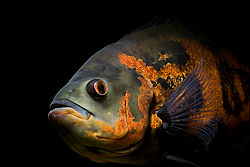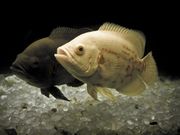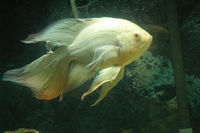Oscar (fish)
| Oscar | |
|---|---|
 |
|
| Conservation status | |
|
Least Concern (IUCN 3.1) |
|
| Scientific classification | |
| Kingdom: | Animalia |
| Phylum: | Chordata |
| Class: | Actinopterygii |
| Order: | Perciformes |
| Family: | Cichlidae |
| Subfamily: | Astronotinae |
| Genus: | Astronotus |
| Species: | A. ocellatus |
| Binomial name | |
| Astronotus ocellatus Agassiz, 1831 |
|
Astronotus ocellatus is a species of fish from the cichlid family known under a variety of common names including oscar, tiger oscar, velvet cichlid, or marble cichlid.[1] In South America, where the species naturally resides, A. ocellatus are often found for sale as a food fish in the local markets.[2][3] The fish can also be found in other areas including China, Australia, and the United States. Although its slow growth limits its potential for aquaculture, it is considered a popular aquarium fish.[4][5][6]
Contents |
Taxonomy
The species was originally described by Louis Agassiz in 1831 as Lobotes ocellatus, as he mistakenly believed the species was marine, later work assigned the species to the genus Astronotus.[7] The species also has a number of junior synonyms: Acara compressus, Acara hyposticta, Astronotus ocellatus zebra, and Astronotus orbiculatus.[8]
Description
A. ocellatus have been reported to grow into a length of 34 cm (approximately 15 in) and a mass of 1.6 kg (2.6 lb).[1] The wild caught forms of the species are typically darkly coloured with orange ringed-spots or ocelli on the caudal peduncle and on the dorsal fin.[5] It has been suggested that these ocelli function to limit fin-nipping by piranha (Serrasalmus spp.) which co-occur with A. ocellatus in its natural environment.[7][9] The species is also able to rapidly alter its colouration, a trait which facilitates ritualised territorial and combat behaviours amongst conspecifics.[10] Juvenile A. ocellatus have a different colouration from adults and are striped with white and orange wavy bands and have spotted heads.[7]
Distribution and habitat

A. ocellatus is native to Peru, Colombia, Brazil, and French Guiana and occurs in the Amazon river basin, along the Amazonas, Içá, Negro, Solimões, and Ucayali river systems, and also in the Approuague and Oyapock drainages.[1][2] In its natural environment the species typically occurs in slow moving white-water habitats, and has been observed sheltering under submerged branches.[5] Feral populations also occur in China,[11] northern Australia,[12] and Florida, USA[13] as a by-product of the ornamental fish trade. The species is limited in its distribution by its intolerance of cooler water temperatures, the lower lethal limit for the species is 12.9 °C (55.2 °F).[14]
Sexual Dimorphism
Although the species is widely regarded as sexually monomorphic,[5] it has also been suggested that males grow more quickly, and in some naturally occurring strains, males are noted to possess dark blotches on the base of the dorsal fin.[6][7] The species reaches sexual maturity at approximately one year of age and continues to reproduce for nine to ten years. Frequency and timing of spawning may be related to the occurrence of rain.[15] A. ocellatus are biparental substrate spawners, though detailed information regarding their reproduction in the wild are scarce.
It has been observed that the closely related Astronotus crassipinnis may, in times of danger, protect its fry in its mouth in a manner reminiscent of mouthbrooding geophagine cichlids. This behaviour, however, has not yet been observed in A. ocellatus.[6] In captivity, pairs are known to select and clean generally flattened horizontal or vertical surfaces on which to lay their 1,000 to 3,000 eggs. Like most cichlids, A. ocellatus practice brood care, although the duration of brood care in the wild remains unknown.[6]
Feeding
Captive oscars may be fed prepared fish food designed for large carnivorous fish, crayfish, worms, and insects such as flies or grasshoppers. Live feeder fish can be given, but fish such as goldfish and rosy red feeder minnows should not be fed. They are typically kept in filthy conditions within the pet store, and will spread disease to oscars, as well as containing an enzyme within their flesh which binds vitamin B1, leading to deficiency. Most fish eaten by A. ocellatus in the wild are relatively sedentary catfish, and included Bunocephalus, Rineloricaria, and Ochmacanthus species.[9] The species uses a suction mechanism to capture prey,[16] and has been reported to exhibit "laying-on-side" death mimicry in a similar fashion to Parachromis friedrichsthalii and Nimbochromis livingstonii.[17][18] The species also has an absolute requirement for vitamin C and develops health problems in its absence.[19]
Selective breeding

A number of ornamental varieties of A. ocellatus have been developed for the aquarium industry. These include forms with greater intensity and quantities of red marbling across the body, albino, leucistic, and xanthistic forms. A. ocellatus with marbled patches of red pigmentation are sold as red tiger oscars, while those strains with mainly red colouration of the flanks are frequently sold under the trade name of red oscars.[20] The patterning of red pigment differs between individuals; in the United Kingdom, one A. ocellatus reportedly had markings that resembled the Arabic word for "Allah."[21] In recent years long-finned varieties have also been developed. The species is also occasionally artificially coloured by a process known as painting.[22]
References
- ↑ 1.0 1.1 1.2 Froese, R. and D. Pauly. Editors.. "Astronotus ocellatus, Oscar". FishBase. http://filaman.uni-kiel.de/summary/SpeciesSummary.php?id=3612. Retrieved 2007-03-16.
- ↑ 2.0 2.1 Kullander SO.. "Cichlids: Astronotus ocellatus". Swedish Museum of Natural History. http://www2.nrm.se/ve/pisces/acara/as_ocell.shtml. Retrieved 2007-03-16.
- ↑ CC. Kohler, WN. Camargo, ST. Kohler F. Alcantara, M.Rebaza, S. Tello, M. Del Aguila, G.Alvarez, M.Chonta, M. Maldonado, M. Magariños, A. Antezana, MA. Villacorta C., R, Roubach, S.Duque, E.Agudelo, C. Augusto Pinto, S. Ricaurte, J Machoa.. "Aquaculture Crsp 22nd Annual Technical Report". Oregon State University, USA. http://pdacrsp.oregonstate.edu/pubs/technical/22tch/03-11SDFR1.pdf. Retrieved 2007-03-16.
- ↑ Keith, P. O-Y. Le Bail & P. Planquette, (2000) Atlas des poissons d'eau douce de Guyane (tome 2, fascicule I). Publications scientifiques du Muséum national d'Histoire naturelle, Paris, France. p.286
- ↑ 5.0 5.1 5.2 5.3 Staeck, Wolfgang; Linke, Horst (1995). American Cichlids II: Large Cichlids: A Handbook for Their Identification, Care, and Breeding. Germany: Tetra Press. ISBN 156465169X.
- ↑ 6.0 6.1 6.2 6.3 Loiselle, Paul V. (1995). The Cichlid Aquarium. Germany: Tetra Press. ISBN 1-56465-146-0.
- ↑ 7.0 7.1 7.2 7.3 Robert H. Robins. "Oscar". Florida Museum of Natural History. http://www.flmnh.ufl.edu/fish/Gallery/Descript/oscar/oscar.html. Retrieved 2007-03-18.
- ↑ Froese, R. and D. Pauly. Editors.. "Synonyms of Astronotus ocellatus". FishBase. http://filaman.uni-kiel.de/Nomenclature/SynonymsList.cfm?ID=3612&GenusName=Astronotus&SpeciesName=ocellatus. Retrieved 2007-03-21.
- ↑ 9.0 9.1 Winemiller KO (1990) Caudal eye spots as deterrents against fin predation in the neotropical cichlid Astronotus ocellatus. Copeia 3: 665-673
- ↑ SC. Beeching (1995) Colour pattern and inhibition of aggression in the cichlid fish Astronotus ocellatus. Journal of Fish Biology 47: 50.
- ↑ X. Ma, X. Bangxi, W. Yindong and W. Mingxue (2003) Intentionally Introduced and Transferred Fishes in China’s Inland Waters. Asian Fisheries Science 16: 279-290.
- ↑ Department of primary industry and fisheries.. "Noxious fish - species information". Queensland Government, Australia. http://www2.dpi.qld.gov.au/fishweb/14477.html. Retrieved 2007-03-16.
- ↑ United States Geological Survey.. "NAS - Species FactSheet Astronotus ocellatus (Agassiz 1831)". United States Government. http://nas.er.usgs.gov/queries/FactSheet.asp?speciesID=436. Retrieved 2007-03-17.
- ↑ Shafland, P. L. and J. M. Pestrak. 1982. Lower lethal temperatures for fourteen non-native fishes in Florida. Environmental Biology of Fishes 7:139-156.
- ↑ Pinto Paiva, M & Nepomuceno, FH (1989) On the reproduction in captivity of the oscar, Astronotus ocellatus (Cuvier), according to the mating methods (Pisces - Cichlidae). Amazoniana 10: 361-377.
- ↑ TB. Waltzek, PC. Wainwright (2003) Functional morphology of extreme jaw protrusion in Neotropical cichlids. Journal of Morphology 257: 96-106.
- ↑ Tobler, M. (2005) Feigning death in the Central American cichlid Parachromis friedrichsthalii. Journal of Fish Biology 66: 877-881.
- ↑ Gibran, FZ. (2004) Dying or illness feigning: An unreported feeding tactic of the Comb grouper Mycteroperca acutirostris (Serranidae) from the Southwest Atlantic. Copeia 403–405.
- ↑ DM. Fracalossi, ME. Allen, DK. Nicholsdagger & OT. Oftedal (1998) Oscars, Astronotus ocellatus, Have a Dietary Requirement for Vitamin C. The Journal of Nutrition 128:1745-1751.
- ↑ Sandford, Gina; Crow, Richard (1991). The Manual of Tank Busters. USA: Tetra Press. ISBN 3-89356-041-6.
- ↑ BBC News (2006-01-31). "Tropical fish 'has Allah marking'". BBC, UK. http://news.bbc.co.uk/2/hi/uk_news/england/lancashire/4667610.stm. Retrieved 2007-03-18.
- ↑ Mike Giangrasso. "Death by Dyeing - dyed fish list". Death by Dyeing.org. http://www.deathbydyeing.org/colormedead.htm. Retrieved 2007-03-18.